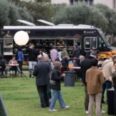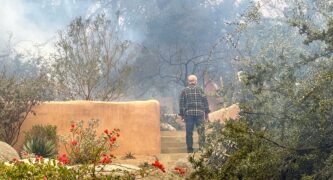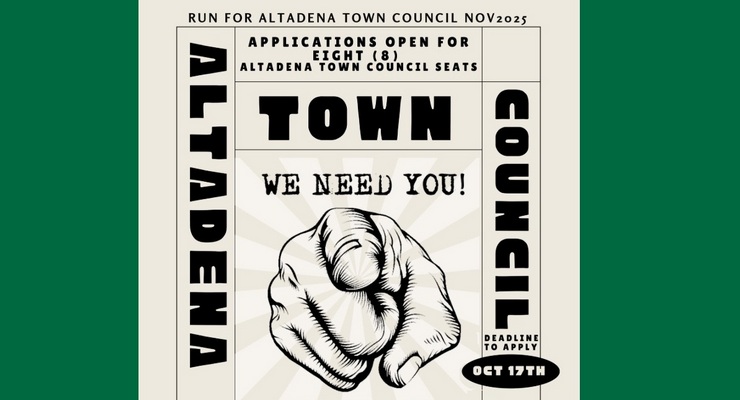
I thought I could get back home early.
I set my alarm for 3:30 a.m. on the morning of Wednesday, January 8, some ten hours after the start of the fire, thinking that I could dash out the door by 4 a.m., hopefully grab some fire footage, and maybe interview a fire captain at a street command post somewhere in Altadena.
I was already far too late. I was somewhere near the middle of the worst of the Eaton Canyon fire. And things were only growing from there. The firestorm had already blown from east to west through Altadena like a hurricane, and by the approaching dawn, nearly a thousand homes had already been wiped out.
Leaving my home about 18 minutes away from the heart of the firestorm, flaming ashes were already swirling everywhere, and as I headed up Lake Avenue, a Sheriff’s deputy stopped me and told me to turn around. I explained that I was part of the media and needed to cover the fire.
I could swear he rolled his eyes at me, and then said, “Turn around. These streets are closed.”
Straight ahead, I could see dark deep-orange fire skies and a thin strip of light blue daylight sitting atop the upper ridge of the San Gabriel Mountains. I made a U-turn down Lake and began to look for any street that would take me directly into the hills and the fire. I snuck east and then headed north to Washington Boulevard.
I was receiving calls from the office every five minutes. “This is on fire! That’s on fire! Can you see any flames?” And then the cell phone service dropped out.
I would soon find out that the reason I wasn’t seeing any flames was that the fire had already roared through this area. From Washington, I moved up Altadena Drive and stopped in a quiet, smoldering parking lot near the Eaton Canyon Nature Center. The fire had already moved through there hours ago. To my right, I could see a smoldering scar through the middle of the Eaton Canyon Wash. I kept moving north along the bottom ridge of the foothills.
Like in a bad western movie, things were quiet. Too quiet.
Moving west on Crescent Drive, I could see some flames, then lots of flames. This street—one of the very last before the actual mountain slopes—was engulfed in flames. And there was no one around. Another home on Pinecrest was being hosed down by two firefighters, the only ones I saw in the entire neighborhood.
Firefighters had long moved on to save the homes that they could.
Moving along Pinecrest, I could see that the school campus was just smoldering, with still-active flames in the breezeways and in storage facilities just outside the main campus. Further south and west, I could see that the Aveson Charter School campus, near the top of Altadena Drive, had also been wiped out during the night. The smoldering shell of a school bus sat across the street.
As I moved south down the slope of Altadena Drive, it was clear now that most of the neighborhood had been decimated. For blocks, there were only chimneys in smoking yards with gas pipes spewing out flames. And this was only a very small portion of the 9,400 homes and structures that would eventually be destroyed, making this the second-most destructive fire in California’s history.
And there was no one around.
The air was quiet and eerie and still.
By now it was about 6 a.m. Most of Altadena’s residents had fled by the thousands, long hours before. All that could be heard was the crackling of flames and the occasional gas line flare-up. There was little or no cell phone service. Listening to a news radio station, I made my way down the slope of the hill back towards Washington, when my cell phone rang, like it was shouting at me.
“The Jewish Temple and Center is on fire. Can you get there…?”
The fire had leaped down Altadena Drive, just south of Eaton Canyon, and the Temple was a surreal, complete ruin by the time I arrived, with flames engulfing the parts of the structure still standing. Only a solitary fire truck remained, soaking down the property. By mid-morning Wednesday, much of the Altadena business district had already burned or was on fire.
Everywhere around me, dramas played out—bus drivers drove their city buses straight up into the fire to rescue senior citizens from homes and from the Two Palms Nursing Center on Washington Boulevard, just below the Eaton Wash Reservoir. Driving by at about 8 a.m., I could see that firemen were knocking down the last of the flames, and the front lawn and driveway were littered with burned and discarded wheelchairs—though all of the patients had been evacuated safely, miraculously.
At about noon, I was directed to Eliot Arts Magnet School, reportedly actively burning. But when I arrived, only some shrubs on the front lawn appeared to be scorched.
I filed a video report while standing in the median on Lake Avenue, just outside the Grocery Outlet supermarket. Behind me a row of businesses were fully engulfed in flames, including the post office, a florist, a cafe, and a bank. Other businesses could be seen burning on the adjoining block. About a half-mile north, flames were threatening an Arco gas station, and thick black smoke rose into the skies.
As I drove around the corner, behind the Eliot campus, I could suddenly see that the main building, not visible from Lake Avenue, was burning away, with 10 to 20 foot flames leaping into the sky. It had apparently not been burning long, but no firefighters had arrived yet.
With a weak cell phone connection, I was screaming into my phone, “Eliot is on fire! Eliot is on fire!” I didn’t know for quite a while if anyone in the office had heard me. Driving away, I still had not seen or heard any fire engines responding.
Active fires like the Eliot campus broke out all day long on Wednesday, while the fire in the hills above Altadena continued to move to the northwest, as it devoured more than 14,000 acres over the next week.
As one fire commander explained, “It takes five fire trucks to respond to one house fire. There was simply not enough equipment anywhere to fight a fire of this size.”
I had mentioned to Mayor Victor Gordo, and he repeated to others, as we walked to a somber press conference at the Pasadena City College gym, that had only the Chase Bank, one school campus, and one home burned on that fateful day, it would have been a huge regional news story, if not national.
Now multiply that by more than 9,400 structures and 18 lives lost. It became an international story of bravery and recovery.
Like September 11, 2001, locals will mark history as “before the fire” and “after the fire.” Everyone has a fire story now.
So I didn’t get home early that day. I ended up working 21 days straight without a day off.
In June, Pasadena Fire Chief Chad Augustin unveiled an ambitious 10-year expansion plan to the City Council that could cost up to $200 million and require voter approval, citing critical staffing shortages exposed during the Eaton Fire.
It’s unlikely the area will ever see a fire of this magnitude ever again, but if we’ve learned anything in the past decade, it’s that anything can, and maybe will, happen.



















